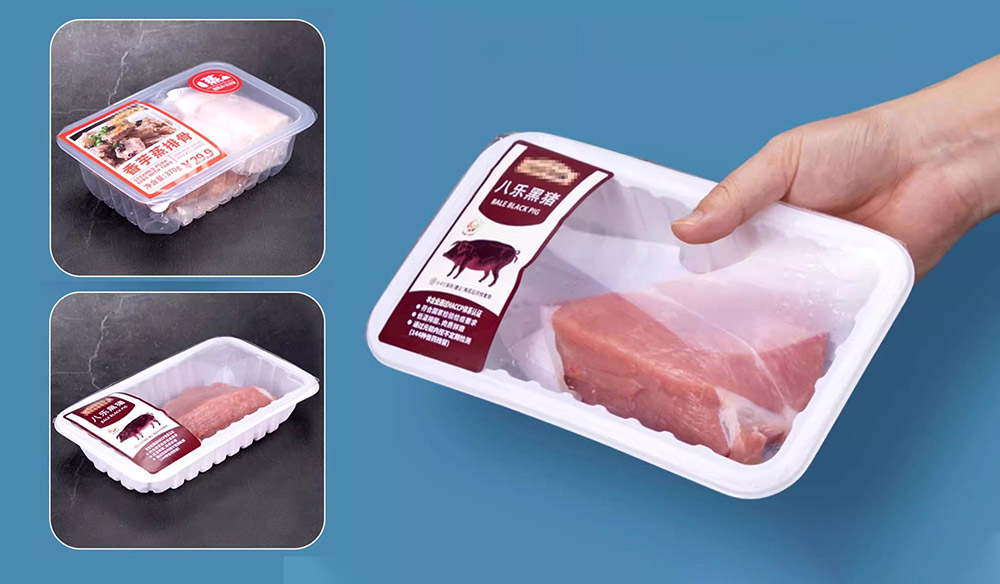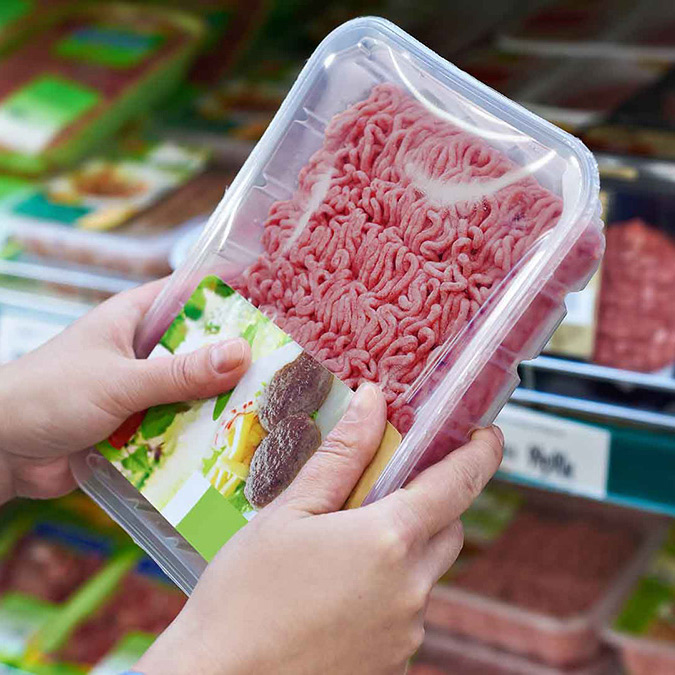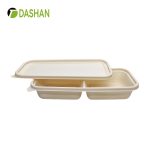Introduction
In the meat industry, packaging is not just about holding the product—it plays a critical role in extending shelf life, maintaining food safety, and enhancing customer appeal. From supermarket displays to international exports, choosing the right packaging method ensures freshness and reduces waste. One of the most effective modern solutions is Modified Atmosphere Packaging (MAP), where PP trays are especially popular for meat products.
In this article, we’ll explore the 7 most common types of meat packaging that every food business should know, along with insights into how innovative PP MAP trays from companies like Xiamen Dashan are shaping the industry.
1. Meat Tray Packaging
Meat trays are widely used in retail environments for displaying fresh cuts of beef, pork, or poultry. These trays are typically made from PET, RPET, or polystyrene foam, sealed with stretch film to keep the product visible and hygienic.
Pros: Affordable, lightweight, clear visibility for consumers.
Best For: Supermarkets, butchers, and retail-ready cuts.

2. Vacuum Seal Packaging
Vacuum sealing removes air from the package, significantly slowing down bacterial growth and oxidation. This method is common for processed meats, steaks, and frozen items.
Pros: Extends shelf life, reduces freezer burn, compact storage.
Best For: Frozen distribution, bulk meat sales, e-commerce.
3. Modified Atmosphere Packaging (MAP)
MAP technology replaces the air inside the packaging with a controlled gas mixture—usually oxygen, carbon dioxide, and nitrogen—to preserve freshness.
Here, PP MAP trays stand out as a reliable choice. Xiamen Dashan produces PP gas-flush trays designed for both high- and low-temperature resistance. These trays offer strong sealing, durability, and excellent clarity—making them ideal for extending the shelf life of beef, poultry, and seafood.
Pros: Maintains color and freshness, extends shelf life, improves presentation.
Best For: Fresh red meat, poultry, seafood, high-value cuts.


4. Poultry Shrink Bags
Shrink bags are designed for whole poultry or large cuts. Once heated, the bag shrinks tightly around the product, reducing excess air and improving storage.
Pros: Cost-effective, protects from freezer burn, suitable for whole birds.
Best For: Whole chickens, turkeys, large bone-in cuts.
5. Retort Pouch Packaging
Retort pouches are heat-resistant laminated bags that allow meat to be sterilized inside the package. They are used for ready-to-eat meals and military rations.
Pros: Long shelf life without refrigeration, lightweight alternative to cans.
Best For: Ready-to-eat products, export markets.
6. Canned Meat Packaging
Canning is one of the oldest methods of meat preservation. Sealed cans undergo sterilization, allowing meat to remain shelf-stable for years.
Pros: Long shelf life, suitable for global distribution, stackable.
Best For: Processed meats, corned beef, exports.
7. Butcher Paper Wrapping
Still popular in butcher shops, this traditional method uses waxed or coated paper to wrap cuts of meat directly. It allows for short-term storage and easy handling.
Pros: Low cost, customizable branding, eco-friendly options available.
Best For: Butcher shops, specialty meat stores.
Comparison Table: Meat Packaging Types
| Packaging Type | Shelf Life Extension | Visibility | Best For |
|---|---|---|---|
| Meat Trays | Short | High | Retail display |
| Vacuum Seal Packaging | Long | Medium | Frozen meats, bulk |
| Modified Atmosphere (MAP) | Long | High | Fresh red meat, poultry |
| Poultry Shrink Bags | Medium | Low | Whole birds |
| Retort Pouch Packaging | Very Long | Low | Ready-to-eat meals |
| Canned Meat Packaging | Very Long | Low | Exports, shelf storage |
| Butcher Paper Wrapping | Short | Low | Butcher shops |
Choosing the Right Meat Packaging
The right solution depends on business needs:
- Retail supermarkets → Meat trays, MAP trays.
- Export markets → Retort pouches, cans.
- E-commerce & frozen supply chains → Vacuum-sealed packs.
- Butchers & local shops → Butcher paper wrapping.
- Poultry farms → Shrink bags.
For businesses focusing on freshness, PP MAP trays have become the standard—ensuring safety, extending shelf life, and presenting products in a professional way.
Conclusion
Meat packaging is evolving with technology, balancing shelf life, safety, and sustainability. Among the options, Modified Atmosphere Packaging (MAP) with PP trays is proving to be the go-to solution for fresh meat businesses. Companies like Xiamen Dashan are supporting global retailers and distributors with high-performance PP MAP trays that meet both functional and environmental needs.
By understanding the strengths of each packaging type, businesses can choose the most effective solution for their products and customers.
FAQ
Q1: What is the best packaging for fresh meat?
A: Modified Atmosphere Packaging (MAP) with PP trays is considered one of the best solutions, as it extends shelf life while keeping meat fresh and visually appealing.
Q2: How does vacuum sealing compare to MAP packaging?
A: Vacuum sealing is great for frozen and bulk storage, while MAP packaging is preferred for retail display of fresh meat due to better color and texture preservation.
Q3: Are PP MAP trays recyclable?
A: Yes. PP trays are recyclable in many regions, making them a more sustainable choice compared to foam or mixed-material packaging.
Q4: Which packaging is best for export markets?
A: Canned meat and retort pouch packaging are ideal for long-distance exports due to their extended shelf stability.
References
- U.S. Department of Agriculture (USDA) – Food Safety and Meat Storage
https://www.fsis.usda.gov - Food and Agriculture Organization (FAO) – Meat Packaging and Preservation
https://www.fao.org - Meat & Poultry Packaging Trends – Packaging Strategies
https://www.packagingstrategies.com - Institute of Food Technologists – Packaging for Food Safety
https://www.ift.org - National Center for Biotechnology Information (NCBI) – Modified Atmosphere Packaging Research
https://www.ncbi.nlm.nih.gov




